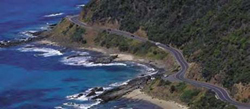Occupying a 240km stretch of Victoria’s south-western coastline, the Great Ocean Road traverses a diverse landscape with deep spiritual connections for Aboriginal people. This includes dramatic coastlines, townships and settlements, rural hinterland and forest along its length from Torquay to Warrnambool. It was constructed between 1918 and 1932.
This case study highlights the natural landscape and the Great Ocean Road as a prominent and continuous thread through a cultural landscape. That thread is inseparable from its earliest inhabitants’ connections, and was a catalyst for the successive waves of change that have created the significant cultural landscape of today.
Applying Victoria’s Framework of Historical Themes illustrates the variety of stories embodied by the place and the strong interactions between the natural environment and the place’s evolution as a cultural landscape, which could be used in interpretation and tourism.
A place of traditional importance
Winding its way along the coast, the Great Ocean Road overlies the traditional country of the Watha-wurrung (Watharong), Gadabanud and Girai-Wurrung language groups of the Kulin Nation.
The Great Ocean Road is defined by stories associated with the revelation of the Ancestral being. The coastal landscape includes natural features that represent creation stories and spiritual connections, for example the Twelve Apostles.
Victoria’s themes and sub-themes:
8. Building community life
8.1 Maintaining spiritual life
A landscape rich in natural resources
The coastal environment was an important source of resources for Aboriginal people, resulting in a high concentration of Aboriginal archaeological sites along the coastal zone.
Victoria’s themes and sub-themes:
2. Peopling Victoria’s places and landscapes
2.1 Living as Victoria’s earliest inhabitants
The area’s natural resources were also the foundation for post-contact European incursions into the landscape of the region, beginning with squatters and pastoralists from the 1830s. Later, extractive industries such as sand, gravel, coal and jarosite mining, and the fishing and timber industries, exploited the area’s natural resources, making physical impacts on the landscape.
Victoria’s themes and sub-themes:
4. Transforming and managing the land and natural resources
4.2 Living from the sea
4.3 Grazing and raising livestock
4.4 Farming
4.6 Exploiting other mineral, forest and water resources
The natural environment is an important catalyst for the area’s early and ongoing popularity as a tourist destination and tourist route. Coastal towns such as Lorne became popular as holiday resorts from as early as the 1870s and 1880s. Visitors were drawn to the scenic ‘beauty spots’, and a variety of recreational pursuits the area offered such as camping, bushwalking, recreational fishing, holidaying, swimming and, later, surfing. From the 1950s and 1960s, tourism went through a second boom period for a combination of reasons, including the vastly improved access to the area by car via the Great Ocean Road.
Victoria’s themes and sub-themes:
5. Building Victoria’s industries and workforce
5.7 Catering for tourists
6. Building towns, cities and the garden state
6.6 Marking significant phases in the development of Victoria’s settlements, towns and cities
A place for sport and leisure
Inaugurated in 1963, surfing contests at Bells Beach near Torquay have long attracted surfers from interstate and, as a venue for world surfing titles in the 1970s, internationally, as well as large numbers of spectators. The establishment of local board-making industries in the 1950s provided the impetus for surfing to become a popular sport. Others commenced local board making and manufacture of surfing goods in the 1960s, with Rip Curl becoming one of the largest surf goods manufacturers in Australia.
A commemorative road and tourist route
Constructed in stages from 1916 to the 1930s as a government-sponsored employment project for returning soldiers, the original section of the Great Ocean Road is regarded as a memorial to the men who served in the Great War. It was also a program chosen to provide access to coastal scenery already recognised as an asset to Victoria as a potential tourist attraction, and to improve the movement of goods to the benefit of local industries.
Victoria’s themes and sub-themes:
5. Building Victoria’s industries and workforce
5.2 Developing a manufacturing capacity
7 Governing Victorians
7.4 Defending Australia and Victoria
8. Building community life
8.5 Preserving traditions and commemorating
9. Shaping cultural and creative life
9.1 Participating in sport and recreation
A scenic landscape
Now one of Victoria’s (and Australia’s) celebrated tourist routes, the Great Ocean Road links a number of significant landscapes such as the Great Otway National Park, the Twelve Apostles and Bells Beach, which are recognised nationally and internationally for outstanding scenery, tourism and recreation values, particularly surfing and touring, as well as natural biodiversity values.
Victoria’s themes and sub-themes:
1. Shaping Victoria’s environment
1.7 Appreciating and protecting Victoria’s natural wonders
3. Connecting Victorian’s by transport and communication
3.3 Linking Victorians by road and rail
By enabling easier access to a previously remote stretch of coast and originally isolated townships and settlements like Anglesea, Aireys Inlet and Lorne, and significant agricultural ports servicing the Western District at Warrnambool, Portland and Port Fairy, construction of the Road facilitated development and growth of the townships and local industries, as well as increasing tourism and recreation visitation.
Victoria’s themes and sub-themes:
5. Building Victoria’s industries and workforce
5.7 Catering for tourists
6. Building towns, cities and the garden state
6.6 Marking the phases in the development of Victoria’s settlements, towns and cities

